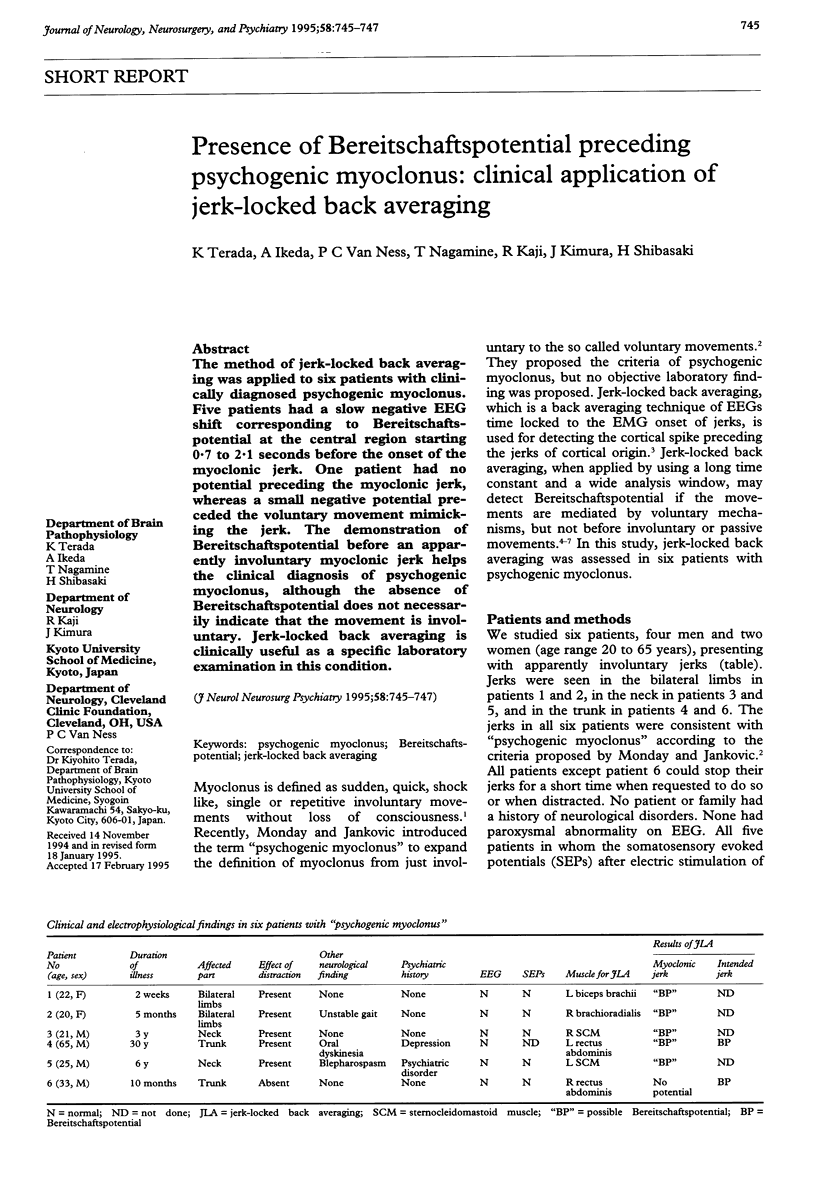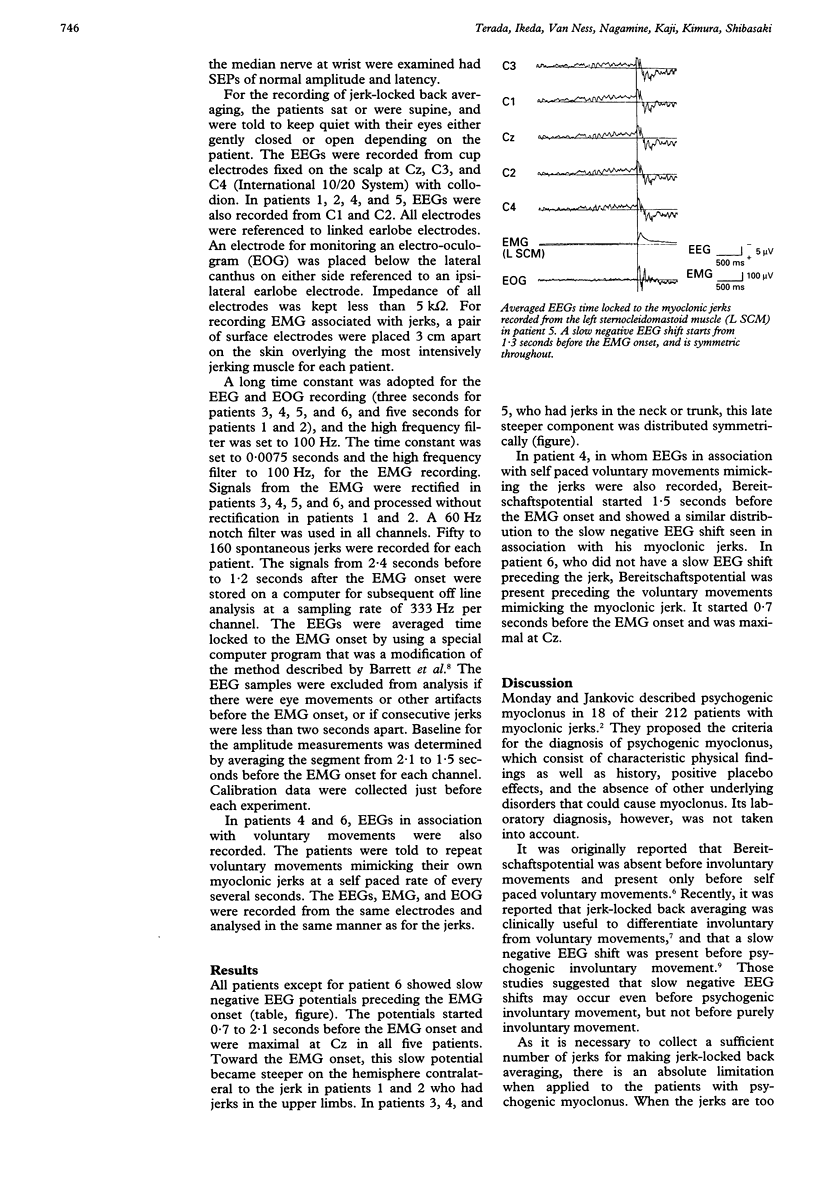Abstract
The method of jerk-locked back averaging was applied to six patients with clinically diagnosed psychogenic myoclonus. Five patients had a slow negative EEG shift corresponding to Bereitschaftspotential at the central region starting 0.7 to 2.1 seconds before the onset of the myoclonic jerk. One patient had no potential preceding the myoclonic jerk, whereas a small negative potential preceded the voluntary movement mimicking the jerk. The demonstration of Bereitschaftspotential before an apparently involuntary myoclonic jerk helps the clinical diagnosis of psychogenic myoclonus, although the absence of Bereitschaftspotential does not necessarily indicate that the movement is involuntary. Jerk-locked back averaging is clinically useful as a specific laboratory examination in this condition.
Full text
PDF


Selected References
These references are in PubMed. This may not be the complete list of references from this article.
- Barrett G., Shibasaki H., Neshige R. A computer-assisted method for averaging movement-related cortical potentials with respect to EMG onset. Electroencephalogr Clin Neurophysiol. 1985 Mar;60(3):276–281. doi: 10.1016/0013-4694(85)90042-2. [DOI] [PubMed] [Google Scholar]
- Cohen L. G., Meer J., Tarkka I., Bierner S., Leiderman D. B., Dubinsky R. M., Sanes J. N., Jabbari B., Branscum B., Hallett M. Congenital mirror movements. Abnormal organization of motor pathways in two patients. Brain. 1991 Feb;114(Pt 1B):381–403. doi: 10.1093/brain/114.1.381. [DOI] [PubMed] [Google Scholar]
- KORNHUBER H. H., DEECKE L. HIRNPOTENTIALAENDERUNGEN BEI WILLKUERBEWEGUNGEN UND PASSIVEN BEWEGUNGEN DES MENSCHEN: BEREITSCHAFTSPOTENTIAL UND REAFFERENTE POTENTIALE. Pflugers Arch Gesamte Physiol Menschen Tiere. 1965 May 10;284:1–17. [PubMed] [Google Scholar]
- Monday K., Jankovic J. Psychogenic myoclonus. Neurology. 1993 Feb;43(2):349–352. doi: 10.1212/wnl.43.2.349. [DOI] [PubMed] [Google Scholar]
- Obeso J. A., Rothwell J. C., Marsden C. D. Simple tics in Gilles de la Tourette's syndrome are not prefaced by a normal premovement EEG potential. J Neurol Neurosurg Psychiatry. 1981 Aug;44(8):735–738. doi: 10.1136/jnnp.44.8.735. [DOI] [PMC free article] [PubMed] [Google Scholar]
- Shibasaki H., Barrett G., Halliday E., Halliday A. M. Cortical potentials following voluntary and passive finger movements. Electroencephalogr Clin Neurophysiol. 1980 Nov;50(3-4):201–213. doi: 10.1016/0013-4694(80)90147-9. [DOI] [PubMed] [Google Scholar]
- Shibasaki H., Kuroiwa Y. Electroencephalographic correlates of myoclonus. Electroencephalogr Clin Neurophysiol. 1975 Nov;39(5):455–463. doi: 10.1016/0013-4694(75)90046-2. [DOI] [PubMed] [Google Scholar]
- Shibasaki H., Nagae K. Mirror movement: application of movement-related cortical potentials. Ann Neurol. 1984 Mar;15(3):299–302. doi: 10.1002/ana.410150317. [DOI] [PubMed] [Google Scholar]
- Shibasaki H., Sakai T., Nishimura H., Sato Y., Goto I., Kuroiwa Y. Involuntary movements in chorea-acanthocytosis: a comparison with Huntington's chorea. Ann Neurol. 1982 Sep;12(3):311–314. doi: 10.1002/ana.410120319. [DOI] [PubMed] [Google Scholar]
- Toro C., Torres F. Electrophysiological correlates of a paroxysmal movement disorder. Ann Neurol. 1986 Dec;20(6):731–734. doi: 10.1002/ana.410200614. [DOI] [PubMed] [Google Scholar]
- Trenkwalder C., Bucher S. F., Oertel W. H., Proeckl D., Plendl H., Paulus W. Bereitschaftspotential in idiopathic and symptomatic restless legs syndrome. Electroencephalogr Clin Neurophysiol. 1993 Apr;89(2):95–103. doi: 10.1016/0168-5597(93)90090-c. [DOI] [PubMed] [Google Scholar]


